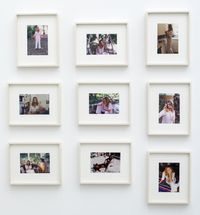Charles Ray's sculptural output is famously small and as varied in process and medium as it is in subject matter. A unifying principal that underscores his practice is that of 'embedment'—encompassing the social, environmental, and spatial qualities of a work as medium—and an often humorous suggestion of the uncanny that gives his sculptures an arresting quality.
Read MoreWhen Ray was attending the University of Iowa, he began incorporating his own body into his sculptural practice. Plank Piece I and II (1973) are two photographs that document his combination of sculpture and performance and the effects of gravity on his own limp form. In the first, a plank pins the artist to the wall at the backs of his knees; in the second, he hangs over the top of the plank from his mid-section, creating a sculpture that unifies materials and craftsman quite literally.
After experimenting with performance and Minimalism, Ray's first figurative sculptures appeared in the 1990s, produced to his specifications by mannequin makers in painted fibreglass with glass eyes. The artist became fascinated with shop mannequins when he worked at a department store during his time at university and began modifying their size and scale to alarming effect. Ray's sculpture Family romance (1993) highlights this disturbing quality, the title alone a cause for concern. It depicts a nude and anatomically correct nuclear family linking hands, the children enlarged so that all the figures are the same height at 4 ½ feet tall.
'Provocativeness' continues to define Ray's practice. In 2015, after being commissioned by the Whitney Museum of American Art to design a permanent sculpture for the public plaza outside of the new museum, the Whitney rejected the proposal for fear that it would 'offend non-museum going visitors.' The sculpture, Huck and Jim (2014), was taken from the Mark Twain classic The Adventures of Huckleberry Finn (1884), depicting the two titular characters in the nude classical tradition—the boy bent over, reaching for an unseen frog, and the man standing about nine feet behind him with his hand raised above his back. Cast in stainless steel and painted white in a later version, the figures are neither marble nor bronze, occupying a similarly ambiguous sexual and racial tension that was deemed inappropriate for a public space.
